Frisia, nostalgic people of the North Sea

Part of Germany and the Netherlands, the Frisians are rich in their differences. Three regions are distinguished: the west, the east and the north. They speak three different languages with a common root: the Anglo-Frisian group.
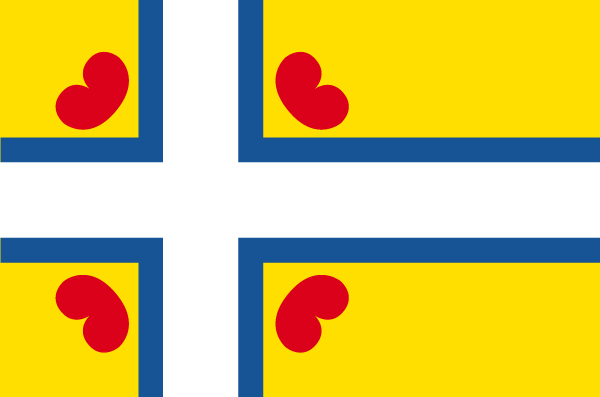
Frisia is situated in an area that stretches from the River Ijssel to the German-Danish border. Between these two points, the Frisians inhabit a 60 km strip bordering the coast. Frisia is mentioned in Roman times by the historian Tacite, under the name of Frisii. In the 6th and 7th centuries, the Frankish chronicles also mention the kingdom of the Frisions. King Aldegisi was the first acknowledged king. His successor, Redbad, a pagan king, defeated Charles Martel at the Battle of Cologne. Around the year 700, the Frisian territory stretched from Bruges (Belgium) to the Weser in Germany. After 1500, Frisia, conquered by other states, was divided up and though the language disappeared from these regions, the feeling of belonging to Frisia remained strong there.
Today, Ljouwert with its 95,000 inhabitants is the biggest city in Friesland. In Friesland (Fryslân), there are 350,000 natives of Frisian, in east Frisia, there are 2,000 people who speak the language in Saterland (east Frisian) and in north Frisia (Nordfriisklön), 10,000 speakers. The Frisian vocabulary permeated by Low German is spoken there. In the province of Groningen, the language used is very close to western Friesland. But the feeling of being Frisian is not very strong among the people of Groningen.

Identity card

| Name | Fryslân | Western Frisian Fraschlönj | Northern Frisian Friislon | Northern Frisian Friisklun | Northern Frisian Fräislound | Saterlandic Freesland | Low Saxon/Low German Friesland | German, Dutch Frisland | Danish (Frisia) |
| Population | 2,300,000 inhab. (including 649,944 in Province Fryslân and 165,507 in Kreis Nordfriesland) (2020 & 2018) |
| Area | 14,000 km² |
| Languages | Frysk | Western Frisian Frasch | Northern Frisian (Mooringer Frasch written standard) Seeltersk/Fräisk | Saterlandic Nedersaksisch/Plaatdüütsch | Low Saxon/Low German Deutsch | German Nederlands | Dutch Dansk | Danish |
| Number of native speakers | 600,000 | Western Frisian (2004) 10,000 | Northern Frisian (2011) 1,500 to 2,250 | Saterlandic (2001) |
| State of guardianship | Germany, Netherlands |
| Official status | Province in the Netherlands, Kreise in Germany |
| Capital | Ljouwert | Western Frisian Leeuwarden | Dutch & Hüsem | Northern Frisian Husum | German & Auerk | Saterlandic Aurich | German |
| Historic religion | Protestant |
| Flag | Ynterfryske Flagge | Western Frisian (Interfrisian flag) |
| Anthem | De âlde Friezen | Western Frisian (The Old Frisians) |
| Motto | None |

Timeline

- 5th century • First written Frisian runes
- 716 • Battle of Cologne. King Redbad defeats the Franks led by Charles Martel. Height of the Frisian language.
- 13th century • Start of the Opstalboom league and the first written law in the Frisian language.
- 1520 • Death of Pier Gerlofs Donia, leader of the Frisian resistance, self-proclaimed king of the Frisians.
- 1744 • East Frisia comes under Prussian law.
- 1879 • First orthograph of the Frisian language (West Frisian).
- 1925 • First Inter-Frisian congress, made up of Frisians from three regions.
- 1951 • Kneppelfreed, riot in the city of Ljouwer. Beginning of the emancipation of the Frisian language.

Brief history

In 1345, William IV of Holland and John, duke of Beaumont, attempted to conquer Frisia by crossing the Zuiderzee with a large naval fleet. Helped by Dutch, French and Flemish knights, they docked on the Frisian shore (Starum, Laaksum) and planned to use the St Odulphus monastery as an assembly point. Having no horses, preferring to carry building materials, the knights ransacked the abandoned villages. The troops of William IV were routed by the Frisian peasants who had been driven into impassable swamps. It is there that William IV lost his life. When John of Beaumont, ally of the Dutch, learned the news, he ordered the retreat. This date marks the resolution of the small people of Frisia against their “great neighbours”. More than an act of war, it was an act of bravery to control their destiny.

Geography

Frisia is found on the banks of the North Sea. Officially divided between two states (the Netherlands and Germany), its historic territory is vast. Today, three reclaimed spaces are once again Frisian: Province of Friesland, East Frisia / Saterland and North Frisia. To these are added the territories of Frisian culture, such as the province of Groningen, the hinterland of Wilhelmshaven and the historical regions of Wuster and Rüstringen near Bremerhaven. Partially formed over the course of the last two glacial periods, this is an area of polders (areas reclaimed by the sea). Upon arrival, the first people created small hills where they lived (w(i)erden). They built ditches to protect themselves from the sea, thus modelling a particular landscape, flat with numerous pastures. The Wadden Sea stretches the length of Frisia from the west towards the north, approximately 500 km. The Frisian Islands form an archipelago which stretches over the entire coast. There are four towns with more than 50,000 inhabitants: Ljouwert: 91,000, Groningen: 180,000, Emden: 51,000 and Wilhelmshaven: 86,000. The majority of Frisians live in the smaller towns or in the countryside.

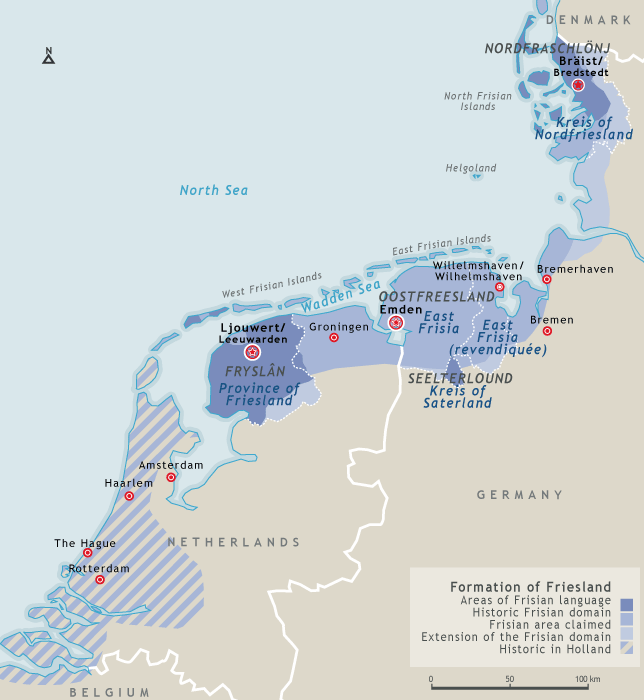

Focus on Province of Friesland (Fryslân)
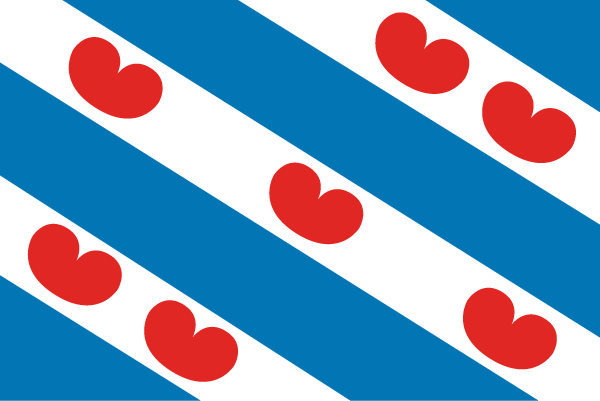
In 1997, the province of Friesland changed its name and officially became Fryslân, a Frisian name that replaced the Dutch name used until this date (Friesland). Fryslân is the Frisian region with the most local native speakers of Frisian. Few differences exist between the dialects of this region. Thus in 1879, the first Frisian orthography was adopted. In 2007, 94% of Frisians declared an understanding of their language and 74% were able to speak it, 75% could read it and 25% could write it. Thus, to be a polyglot is normal for the Frisians. Local life is punctuated by the language, which is broadcast on radio and television. Ice-based sports are one of the distinctive elements of the western Frisians, especially ice skating and fierljeppen (Pultstockspringen in German), which consists of jumps, helped by poles, above the river. The harsh winters permit the use of frozen canals as large ice rinks. This is what the Frisians call Alvestêdetocht (English: Eleven Cities Tour), i.e. a 200 km stretch of ice connecting 11 towns. Finally, the famous Frisian cows or the equally well-known Frisian horses enhance the reputation of the region.

Focus on Nordfriesland
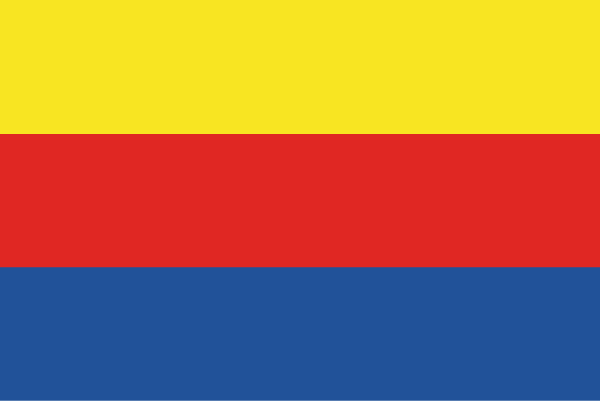
North Frisia (or ‘Nordfriesland’ in German) is now integrated into the region of Schleswig-Holstein. As its name indicates it is at the most northern part of Frisia. North Frisia is traditionally made up of two distinct territories: a continental part and many islands and peninsulas, the main ones being Söl, Feer, Öömrang and Noordströön. Until 1864, North Frisia made up part of Denmark. After being conquered by Germany, three districts were created: Südtondern, Husum and Eiderstedt. In 1970, the three districts were grouped into one, giving a historic coherence to North Frisia. The Frisian language is spoken in this region by 10,000 native speakers. There are many variants that can be classed into two large groups: continental and insular. They correspond to several phases of settlement in this region, which began in the year 700. The “Mooringer Frasch”, i.e. “the Mooring Frisian” plays the role of lingua franca, even if different variants are taught in school.

Focus on Eastfriesland
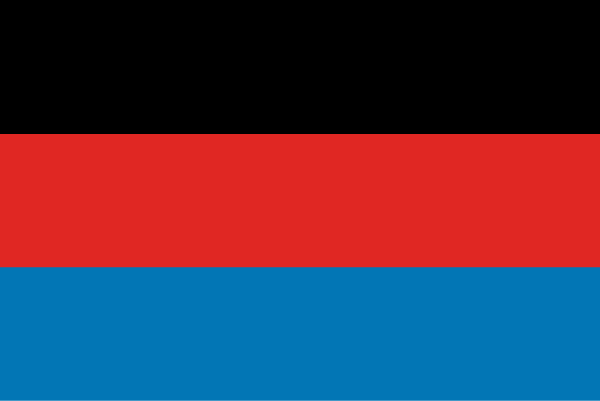
East Frisia remained an autonomous principality until 1744. It is made up of four districts: Auerk, Emden, Lierre and Wittmund. A little more to the east lie the districts of Freesland, Wilhelmshaven and Ammerland. These are historically connected to East Frisia and, from an inter-Frisian perspective, have an important role to play. 700,000 people live in East Frisia. The major towns are Auerk, Emden, Lierre and Wilhelmshaven. The lone region of Saterland (Seelterlound in Frisian) practises the Frisian language called Saterlandic. The other native language spoken nowadays is Low German, of which the Frisian variant is distinctive. Even if the Frisian sentiment is strong in this region, it was only in the 1990s that a real movement began to emerge. In 2007, a political party called “Die Friesen” was set up in order to support Frisian ideas. Apart from specific landscapes and styles, East Frisia is distinguished in cultural terms by the practice of an atypical sport: Boßeln, where the players have to throw a ball over a distance of 10 km. The player who makes the fewest throws wins. Frisia is also known for its tea culture, like the English. This activity gives Frisia its cultural vibrancy and the Frisian friendliness is renowned. All visitors are welcomed to tea, morning, noon and night.

Languages

Frysk, Frasch, Fraïsk…
There is not just one language, but many languages that are spoken in Frisia. Frisian in different forms is spoken throughout the whole of the domain of Frisia. It is a Germanic language, long-time cousin of English, of which written traces have been found in runes dating from the 5th century. Low German or Low Saxon is also spoken. With regards to Frisian, there are three pockets. One to the west of the province of Fryslân, the other to the centre in Saterland and the last to the north of northern Frisia. To the west, in the province of Fryslân, it is spoken by 400,000 of the 600,000 inhabitants. Today the language is protected (Convention on the Frisian Language and Culture 2001) but its advancement still requires the effort of written practice, which is obligatory in primary education. At the centre of this area, it is spoken by a few thousand people in the four Saterlandic communes. In North Frisia, the number of native speakers is around 10,000, but the different language variants (seven) render it difficult for teaching. Its protection in this region could involve the use of a standard, which today tends to be the variety of the Mooring region. Thus the three varieties of the Frisian language will certainly have a very different future. The future of western Frisian is now assured if the efforts and enthusiasm of the population is confirmed. In contrast, the weak protection from which the two varieties on German soil benefit risks the disappearance of this treasure forever.

Politics now

North Frisia was the first region of Friesland to have its own political party. The Union of Electors of South Schleswig was founded in 1948. There is a political representation for the Danish and Frisian minority in the German province of Schleswig-Holstein. In the Dutch province of Friesland, the Frision Nationalist Party was founded in 1962. Polling at 10% in provincial elections, it has five seats and governs a left coalition. A second political party of western Friesland is being created. It is called De Friezen.
Political parties
- Fryske Nasjional Partij / Frisian Nationalist Party (FNP) (Left-wing)
- De Friezen – Die Friesen / The Frisians (Centre)
- Südschleswigsche Wählerverband (SSW), Sydslesvigsk Vælgerforening, Söödschlaswiksche Wäälerferbånd / South Schleswig Voters’ Association (Social democracy)

